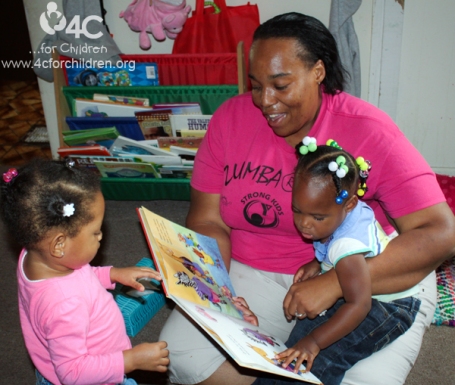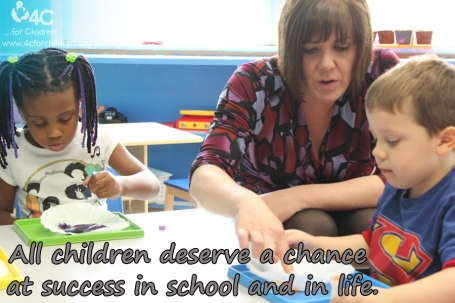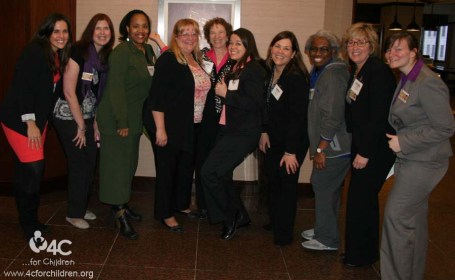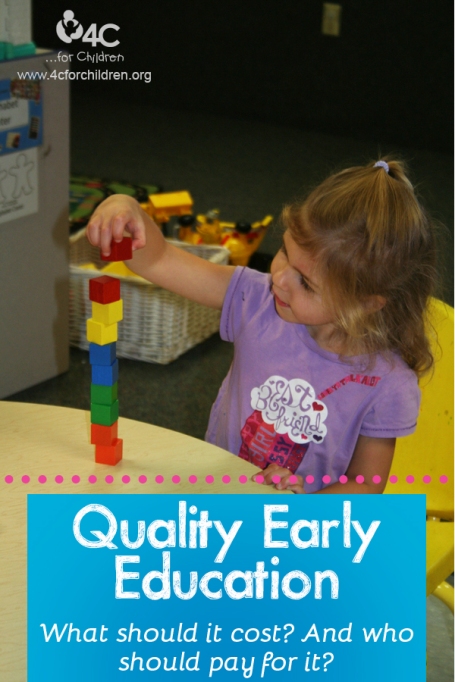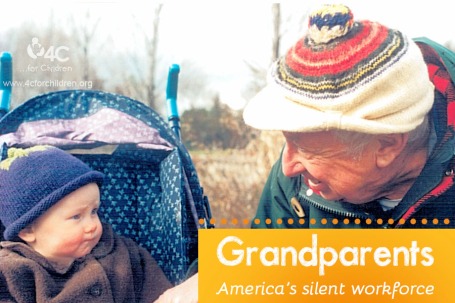And This One Belongs to the Reds: Election Results 2014
“And this one belongs to the Reds.” If Cincinnati Reds announcer Marty Brennaman had been calling the election results this week, his trademark phrase would have been right on the money as the (red) Republicans generally defeated the (blue) Democrats, here in Ohio and Kentucky as well as across the nation.
While the pundits dissect the local, state and national results, I thought I’d take a look to see what the impact may be on early childhood education in Ohio and Kentucky.
Locally there is hopeful news for eventual preschool promise ballot initiatives in Cincinnati and Montgomery County. By fairly wide margins, taxpayers were very willing to support and even increase tax initiatives for things they think are important such as schools, social services and even iconic buildings.
And preschool initiatives fared well in two other major cities, Seattle and Denver where measures passed to expand the quality and access to preschool. Denver’s preschool sales tax will increase while Seattle’s property tax is new. Both provide lessons for us locally.
At the state level Ohio re-elected Governor Kasich. Early childhood education has fared very well under the Governor’s leadership, and the Children’s Caucus, lead by Senator Peggy Lehner (R-Senate District 6) and Representative Michael Henne (R-House District 40) from Dayton, and Representative Denise Driehaus (D-House District 31) from my own district in Cincinnati have pledged to work hard to expand access and quality of preschool, particularly for children from lower-income families. All three were re-elected. I expect to see even more progress in early childhood education at the state level over the next few years.
Nationally, although President Obama has laid out a comprehensive early childhood initiative, we have a majority party now dominating both Houses of Congress that is extremely unlikely to move ahead with any meaningful support in early childhood education. Despite what is otherwise a bi-partisan issue (see Ohio), I don’t expect to see anything other than small steps out of Washington.
Two (local and state) out of three (federal) bodes well for the future of public support for improving quality, affordability and accessibility of early childhood education.
Updates on the Child Care and Development Block Grant
On September 15, 2014, the US House of Representatives passed the reauthorization of the Child Care and Development Block Grant (CCDBG)—the federal law that provides for child care assistance to low-income working families. The CCDBG also provides resources for states to improve the quality of child care. The law was first passed in 1990 and reauthorized in 1996. Since then – not a peep, despite the fact that the American landscape has changed significantly, including the fact that most children in America, including infants, have mothers who work outside the home and who need safe, affordable child care.
The Senate, long expected to pass the bill easily, recessed last week before passing the bill—although only two Senators (Coburn (R-OK) and Toomey (R-PA) had any objections to passing it by unanimous consent. When the Senate returns in mid-November, this should be a high priority.
Grace Reef, an early childhood policy advisor in Washington, D.C., posted an outstanding description of the status and impact of the bill—and of the delay until after the mid-term elections. Rather than restate it, I encourage anyone interested in understanding the importance of the legislation and the process ahead to get it passed to read her post. For those few of us who are interested in the details, Grace also includes a link to compare the current law with the proposed changes.
Grace has had 16 years of experience working in the United States Senate as a senior policy advisor. Most recently, she was the Chief of Policy and Evaluation for seven years at the National Association of Child Care Resource & Referral Agencies (NACCRRA), currently doing business as Child Care Aware® of America. I rely heavily on her to understand what is happening in Washington and to understand how and when 4C for Children should take action on federal issues.
“The fact of the matter is that mothers work. Working families, spurred by working moms, need child care in order to ensure that they can support their families.” Read the rest of Grace Reef’s blog post.
What does this story say about access to child care?
Summer presents extra challenges for working parents of young school-age children—made clear by a recent tale of a South Carolina mom who OK’d her 9 year-old daughter’s request to be left at a community park rather than having to hang around at McDonald’s while her mother worked. The park had a splash pool, playground, friends and free breakfast and lunch. The McDonald’s had…well, you know: nothing for a 9 year-old to do all day.

The mom, Debra Harrell, was arrested for neglect, jailed for four days and had her child placed in the child welfare system for nearly three weeks. She now faces a trial and possible (but unlikely) prison time. And so the debates rage. One debate is whether the government should have a say in such child-rearing decisions. The Washington Post said it this way,
“Her arrest sparked debate about ‘helicopter parenting’ versus the ‘free-range kids’ approach, a movement designed to fight ‘the belief that our children are in constant danger from creeps, kidnapping, germs, grades, flashers, frustration, failure, baby snatchers, bugs, bullies, men, sleepovers and/or the perils of a non-organic grape,’ according to one website.”
Another debate, central to the interests of 4C for Children, is: What are the alternatives? Ms. Harrell was trying hard to play by the rules. She had had troubles in her past but cleaned up her act, has been working for five years at McDonald’s to support her daughter and by all accounts seems to be a responsible parent. Her daughter is happy and healthy and on the honor roll at school. In fact, a month after the arrest, Ms. Harrell was promoted.
But Ms. Harrell was working at a company that pays federal minimum wage, $7.25 per hour. There is no way that a full-time employee can afford child care with the wages paid by McDonald’s and other fast-food restaurants. Limited child care subsidies are available in some states but are often inadequate to cover the real costs. What’s more, few good options exist for school-age children like Ms. Harrell’s daughter; 9, 10, 11, and 12-year-olds with energy and creativity do not want to spend the summer months being “babysat.” So parents are left with the dilemma of “can’t find it, couldn’t afford it anyway.” What system jails a mom for leaving her school-age daughter in a park to play? Ms. Harrell wasn’t out partying—she was working to support her daughter. I do think it is wrong to leave a child of 9 without designated adult supervision, but what are the alternatives? This mom felt she had no choice, and perhaps she really didn’t.
Here is where public policy and public resources come in to play. We need choices for school-age children—choices that are fun, educational, and healthy—and ones that low-wage, working parents can afford. Children from low-income families are the most vulnerable to academic “summer slide” as well. School and future success depend on having meaningful summer opportunities.
A separate issue, not addressed in any of the articles I read about this story, is that many jobs, including fast food, retail and home health care have varying, rotating and unpredictable work schedules, often nights and weekends. Some even call workers in day by day—or not, depending on just-in-time needs. Such jobs (sometimes the only jobs available) are incompatible with most child care businesses. A child care provider can’t make ends meet either when she cannot plan for attendance.
I wish Debra Harrell and her daughter the best. There has been an outpouring of both criticism and support. In fact, one supporter set up a crowd funding appeal and raised $42,000 for the family’s needs, including her daughter’s education.
I also hope (and will continue to work) for more sufficient and appropriate options for school-age children to become available–during the summer and all year long.
Leading the way to a new era!
The following is a guest post from 4C’s immediate past Board Chair, Davida Gable.
Caregiving is a skill. In addition to requiring individuals of excellent character, it requires education. Each day, researchers are making new child care discoveries, validating some practices and discrediting others. We know more about brain development than our parents did. Perusing 4C’s workshops, one encounters the education required for caregivers with classes including language and literacy, cognition, motor development, learning environments, music, social competence, emotional development…even biting!
For too long, society has not acknowledged the skills and education required for quality caregiving. Some people accord quality caregivers with no more importance – or compensation – than they would give babysitters. When the skill is recognized, it’s sometimes considered innate to women, ignoring the generational traditions of families actively teaching offspring how to care for children.
With the decline of these generational teaching traditions and the rise of research and learning about children, society is embracing that caregiving is a skill and that caregivers must be educated. Fewer mid-20th century family structures and disappearing inter-generational involvement increases the demand for public support of caregiving. The advocacy for early childhood care and development has been growing to a crescendo. These are exciting times!
Because attitudes about caregiving are changing, 4C for Children embarked on an ambitious strategic planning journey to update and clarify our values, mission and vision. We explored and debated different ideas from the child care experts in 4C, parents, community leaders, the 4C board, and caregivers.
The results are new guiding statements that will lead us into this new era:
Foundation
We believe the best way to impact young children is to help the adults who care for them.
Mission
4C for Children educates and supports the adults who care for young children and advocates for public support for quality early education and care for all children.
Vision
All children have a quality early learning experience, enter school ready to succeed, and reach their full potential.
While 4C for Children has always understood the impact caregivers have on children, it has never declared its work with such conviction.
I told the 4C Board of Trustees that I would post this unflattering picture of me in a blog expressing our gratitude to the caregivers of 4C and our communities if we achieved 100% board member participation in pledging financial support to 4C for Children. Sure enough, the 4C for Children board is continuing 100% participation!
I think my late mother smiled in this picture because she knew that it would highlight one of the many challenges that she – as a caregiver – encountered. I believe that she is smiling now, excited for the new era of child care that we are creating. Unlike the petulant scourge in this photo, I know that I am smiling, too. 4C for Children is ready to educate and advocate to impact children’s lives!
Good things Come to Those Who Wait – or Push – Part 2
In my last blog, I listed some public policy achievements at the Federal level. It is hard to measure results in advocacy because nothing ends up looking quite like you envisioned. Sometimes it takes many years, and sometimes the political winds never come the way of the issues we care so much about.

It’s not time to jump for joy quite yet, but there have been a lot of advances made in ECE policy in Ohio and Kentucky lately!
But here are a couple of things that have been accomplished or are likely to succeed at some level:
Licensing of Family Child Care in Ohio – Ohio child care resource and referral agencies have been leading the effort to ensure that every child in Ohio who is in a child care setting has health and safety protections. For decades, Ohio has been one of only five states that has not licensed home-based child care businesses that serve six or fewer children for a fee. We never did get a bill through the Ohio General Assembly (this was done by “rule”), but we have a significant – albeit incomplete – improvement. Effective January 1, 2014, Ohio now has licensing for family child care providers who serve children receiving publicly funded child care. There are still thousands of children in legal, unregulated child care – without any standards, trained caregivers or other safety measures – because the state’s priority (rightly, I think) is for those children whose care is partially or fully paid by the taxpayers. We now have licensing. Next we have to get all those operating a child care business required to be licensed.
Administrative and policy changes to strengthen the child care system in Ohio for children of working families. Did you know that if a parent receiving publically funded child care loses a job, or has any break in work (e.g., maternity leave) the child loses his or her early learning program – mid-year or at any time? New legislation in Ohio aims to correct that. This soon-to-be-introduced bill has a great deal of support, but some of the really important provisions may be eliminated – such as a plan to pay a provider based on enrollment and not penalize a center or family child care home because the parent does not bring the child on a particular day. No business can operate with the type of uncertainty that child care experiences. And a child care program cannot build the type of quality that our society is demanding when they don’t know if they will meet payroll through no fault of their own. This is a fix that is still necessary, but that does not diminish the importance of the plan to ensure children can be authorized for a full year even though a parent’s work status changes.
Restoration of Kentucky’s child care subsidy to pre-freeze levels. In April 2013 Kentucky froze all intake for child care financial assistance and then, on July 1, 2013, any child whose family was over the poverty level was kicked off the child care subsidy program. The freeze meant that low-income families did not have the resources to go to work and that first-time parents, at even the lowest wage, had to scrounge for any available person to watch their children. The repercussions have been wide – centers closing or closing classrooms, family child care providers going out of business, teachers laid off, parents losing jobs. Restoring these cuts has been the number one public policy effort of 4C and its Northern Kentucky advocacy partners requiring intensive communication strategies and time. Governor Beshear has recommended the restoration of the eligibility levels and reopening the child care financial assistance program. It appears that the Kentucky Legislature agrees, but that is yet to be seen, so the intensive work continues.
Good things Come to Those Who Wait – or Push – Part 1
It is nearly impossible to measure outcomes of advocacy as there are so many twists and turns – and time lags – and especially compromises when working on public policy issues. Sometimes you put a lot of time and effort into policies that never get enacted. Sometimes things happen from a regulatory or administrative action instead of the legislation you’ve been working to pass. Other times incremental changes occur and it feels disappointing that we didn’t get the big win. But here are some recent wins for children that are a result, in part, of the efforts of 4C and many other advocates.
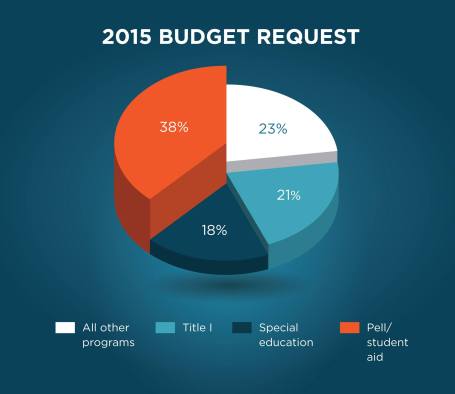
This graphic from the US Department of Education depicts the amount of the proposed 2015 education budget going toward different initiatives. Read more on the proposed budget.
Today, I’ll mention two federal items, and in a later blog some state issues.
The deed is not done until the reauthorization of the Child Care and Development Block Grant passes the House and is signed into law, but nearly unanimous Senate passage is a great start. This bill, the primary legislation and funding for child care for low-income working parents, was first passed in 1995, reauthorized in 1997, and not touched since. Every year a team from 4C has gone to the nation’s capital to advocate for improvements to the law – such as a requirement for comprehensive background checks for those working with young children, an increased focus on quality early learning (not just safe care but learning environments as well), and requirements to pay child care providers a fair rate. The Senate passed the bill this month with great support from Ohio’s Senators. It is now on to the House with a first hearing next week. This thing could actually happen, and 4C staff will be on the Hill this week to push forward.
The Federal budget has increased for Head Start (well, restored to pre-sequestration levels), and for new child care/Early Head Start Partnerships. Of course I’d love to see a grand comprehensive early childhood education bill that addresses the many barriers to ensuring high quality early care and education for all who want or need it. But the reality is this: Since President Nixon vetoed the last comprehensive legislation in 1972, we’ve seen only bits and pieces get proposed, and of those only pieces get enacted. So when the FY2015 budget passed the U.S. Congress this year, we were very happy to see three initiatives with resources to expand/restore Head Start, initiate new partnerships between infant/toddler child care and Early Head Start, and other systems improvement.
These are all positive steps. I’m still holding out hope for sweeping systemic changes that will ensure fair pay for teachers who have appropriate education and services that all families can afford.
Advocacy as a Team Sport
Ten staff members from 4C for Children joined about 60 other advocates at the Ohio Statehouse last week. The goal was to educate about and advocate for high-quality child care and early education. After a briefing on proposed legislation to improve access for children from low-income working families, we spread out to meet with legislators and their aides. Between us, we met with about a dozen Miami Valley and Southwest Ohio legislators and/or their aides. For most of our team, this was the first such experience and all felt a sense of exhilaration in participating in our democratic process. I asked those who were “newish” as well as those more experienced to jot down their impressions. Here are some comments.
Shelley Nelson, Education and Outreach Coordinator in Parent Services: “Words cannot describe how I felt knowing that I, as a former infant teacher, center director and recent college graduate had been given this opportunity to tell our stories and to make such a difference in children’s lives. The energy around early childhood education sends chills up my spine, knowing I am from the generation that says early learning is just as important as K-12 and to have policymakers in the great state of Ohio agree.”
Paige Runion, Leadership Coach: “We watched Sallie model introductions and we listened carefully to how she phrased her opening descriptions of the legislation we were there to discuss, a new bill not yet introduced. Soon our own stories sprang out of our mouths. Our passion for children and their families outweighed our hesitancies. Will I return next year? Absolutely. And now I’m wondering what Capitol Hill looks like on the inside.”
Lorna Chouinard, Director, 4C Miami Valley: “Advocacy means such different things for different people. Watching those around me – those who were brand new just taking it in and the old pros, calm and collected! It was inspiring! For me, this was a time to thank those elected officials who work on our behalf and to educate those who still think that child care is babysitting and early investment is a waste of money. Looking forward to doing it again in a few short weeks in Washington.”
Annetta Rutland, Director, Family Child Care Services: “Today I felt like a newbie although it has only been about three years since I last made advocacy visits. We met with six legislators or their aides. Here are some of my take-a-ways:
- HB59 (new high quality preschool spaces) is working as 75% of the slots are full with new children. (Happy to hear).
- Ohio has the second lowest pay for child care in the nation. (Sad to know).
- ‘Enrollment verses attendance,’ ‘presumptive of eligibility’, ‘continuous authorization’—these are pieces of the new bill being introduced soon. (It is a good starting point but we also must get higher rates for providers).
All in all it was a good day.”
Lori Shrider, Communications Specialist: “I am relatively new and Advocacy Day was an eye-opener for me. There are so many important aspects about early childhood education, and many people who are affected, and so it is hard to wrap my brain around it! It is important that we continue to have days like this, where all of the people who are affected by early childhood issues–directors of child care centers, teachers and parents–come together around a single issue. When we work together, we can accomplish great things and we can show that our voices deserve to be heard from the Statehouse to Capitol Hill!”
Kim Ginn, Director of Professional Development: “Being the activator that I am, meeting with aides during my first Advocacy Day three years ago brought relief and disappointment at the same time–relief due to overcoming my nervousness on what to say and disappointment because I thought the aides could not make a difference. I have discovered if you truly believe in your cause, it is easy to share. And regardless of who you meet with, they want to hear your story, and it does make a difference! This year, I joined with others who provide direct services to children. I presented the big picture and they shared the direct impact on children and families. It was an incredible experience. Having multiple voices giving the same message put early childhood education on the minds of many in Columbus.”
Delorise Pennington, Leadership Coach: “Advocacy day felt like a dream come true. Sharing my early childhood experiences with legislators and their aides was phenomenal. At first I was a little nervous, however, as the day went on, watching Sallie share with policymakers gave me the courage to share too. Advocating for children has been one of my personal lifelong missions, so this was a great opportunity to take my advocacy to the next level. Now it’s time for national advocacy.”
My particular excitement came from two things. First, that we were receiving such a positive response from legislators from both sides of the aisle and, second, the degree to which our 4C team became active leaders in advocacy. We each had an important role to play – a great team.
View more pictures of our Advocacy Day visits on the 4C for Children Facebook page!
An exciting day for Kentucky families
The following is a guest post from 4C’s Director of Kentucky Services Julie Witten.
“Fund Kids First!” was the rallying cry on January 16 at the annual Children’s Advocacy Day in Frankfort, Kentucky. Close to a thousand advocates from across the state descended on the Capitol for a rally and legislative meetings in support of children’s issues. I go to this event every year, but this year was different.
It was different for me because I have felt passionate that something must be done about the cuts to the child care assistance program in Kentucky that went into effect last April. Over the past year I have heard devastating stories of how the cuts have negatively impacted families and child care centers. Child care assistance gives working families a leg up, so they can get and keep jobs and work their way toward self-sufficiency. The cuts have meant that families already struggling to make ends meet have had to choose between work or reliable child care. I wanted to fight this, and so have many others!
This is the point where I should tell you that there is a silver lining to this story. I promise!
But first, let’s go back to the Capitol for a minute. Children’s Advocacy Day is coordinated by Kentucky Youth Advocates, the only multi-issue statewide children’s advocacy organization in Kentucky. Amongst 4C for Children’s top priorities is advocating for policies that support the healthy development of young children. This, along with our work of improving quality in child care centers and supporting the families of young children make up 4C’s three-pronged approach to improve outcomes for all young children in our region.
There was an air of excitement as we walked into the Capitol. I could feel the energy pulsing from the rotunda, where people had started gathering. With my talking points under one arm and my “fund kids first” foam finger under the other, I walked to our first appointment. I was accompanied by 4C Board members and a child care director, representing important perspectives on this issue. We had meetings with eight different legislators from the House and Senate. I was overjoyed that all of them understood the issue and felt that it was important, even though some would need more convincing on where the funding might come from.
Meeting with the legislators that day was a pre-emptive strategy to increase their understanding of the child care assistance issue prior to the Governor’s budget proposal. We had heard that to Governor would reverse the cuts in his budget, but we had to get members of the House and Senate behind us so they would preserve that area of the budget when it reached the legislature. We told stories, shared facts on the benefits of quality early education, and waved our foam fingers through our eight meetings and a rally with the Governor.

4C Northern Kentucky Advisory Board member Michelle Kolb, board chair Janice Cushman and Director of Kentucky Services Julie Witten
On January 21, Governor Steve Beshear addressed the Kentucky legislature and the citizens of the Commonwealth and presented his budget. Spoiler alert, he has proposed full reinstatement of the child care assistance program. He also presented unprecedented investments in education, now making a name for himself as the “Children’s Governor”. This is great news!
But our work is not finished. The budget will face scrutiny in both the House and Senate, so we will keep up the fight.
So now you may be thinking, “Well this all sounds great, but will it make a difference?” I have to think it will, because the alternative is just depressing. We wouldn’t be where we are now, if it hadn’t been for the collaborative efforts of organizations, child care programs, and parents over the past year. Best of all, there is a super simple way that you can help: join Kentucky’s Voice for Early Childhood and respond to the action alerts. You’ll be in very good company, over 1,000 messages were sent to legislators just last week.
The future of Kentucky depends on children getting a solid start. I’m fighting for the future, are you?
Families and the High Cost of Child Care — 2013 Version
Is there an echo here? In May of this year, 4C issued a report entitled “The High Cost of Child Care: A Challenge for Working Families.” The 4C report focused on data from Greater Cincinnati, Greater Dayton and Northern Kentucky and concluded that the high cost of child care is a barrier to employment for many parents and a significant financial burden for all but the most affluent.
On Nov. 4 Child Care Aware® of America issued a report on the cost of child care across the country. This is their seventh such review, and this year’s report does not paint a pretty picture. Nationally, child care costs more than the entire family’s food budget, more than housing, more than college.
Child Care Aware® of America (which is the national membership organization for agencies like ours and a collector of local data—including ours) hit at the dilemma that is so apparent to us as well: child care must not be seen simply as someplace safe for the kiddies while parents are at work, but also as essential to a strong economy.
According to this new report:
Governors and legislators, law enforcement officials and business leaders see quality early care and education as vital to the nation’s economy and security. Military leaders found that 75 percent of young adults are not qualified to join the military due to failure to graduate high school; a criminal record; or physical fitness issues, including obesity. They concluded that America needs early care and education to ensure national security because each of the issues that are decreasing readiness are improved by quality early learning programs.
Child care—whatever you call it—day care, preschool, pre-K—is where the majority of American children are getting their first “school” experiences.
So what should it cost? An even better question is who should pay for it? I would contend that even though child care is largely unaffordable for most but the wealthiest families, it doesn’t cost enough! Teachers are poorly paid and thus are, in essence, further subsidizing the cost. The cost to provide the level of early education that will prepare children for school and the workforce cannot fall solely on parents. Parents don’t bear the financial burden for K-12 education, and most students and/or their parents don’t pay the full cost of college. Since nearly the founding of our country, we have understood that an educated populous benefits every one of us, and thus we spread the cost to everyone through taxes.
So what does the new report tell us? Right here in our communities and across the nation, child care is hugely expensive for most families. But since we know for a fact that high quality early education is the best strategy to ensure a ready child, ready community and ready workforce, when are we going to finance child care and pre-K in a way that works for us all?
America’s silent workforce: Car Seat Grandmas
Today’s guest post comes from 4C Board Chair Davida Gable.
There is a silent workforce in our country that has often gone unnoticed. I affectionately call them Car Seat Grandmas. These grandmas have proper car seats hooked into the LATCH system in the back of their cars at all times, ready to glide into the pediatrician’s parking lot with only ten minutes notice. School staff members recognize them, and they already know the directions and days of the week for after-school activities.
I have awesome parents and parents-in-law. I really do. They are cool, hip, active and travel the world… from international locations to the banks of the Ohio River. I praise the skies that my daughters have such fabulous examples of how people can live to the fullest into their sixties and seventies and beyond.
The downside of having cool, hip, active and world-travelling parents is that they are busy with cool, hip activities and travelling the world. When my water broke before the birth of our second child, my Tender Loving Husband called his parents on the way to the hospital, to see if they could take our older daughter for a couple hours. We didn’t even have time to put on her shoes!
“We’re sorry. We can’t because we have a tennis match this evening.”
“Well, can you cancel?”
“You can’t cancel on DOUBLES!”
Following the emergency caesarian section surgery, they called to say they could help since the match got rained out.
While I personally lacked a reliable Car Seat Grandma, in the United States recent Census data revealed that grandparents were the primary source of child care for 30 percent of working women with children under the age of five. 30 percent! I bet these grandparents had car seats in the back of their cars. More importantly, when 30 percent of working women with children under of the age of five need their mothers’ help to maintain employment, it’s clear our society has not addressed the need for affordable, high-quality early child care. Our collective dependence on this group of women – many of whom stayed home to raise their own children – means that our society has been avoiding reconciling women’s desire to pursue careers with an adequate supply of child care.
The most famous Car Seat Grandma of all is our current Grandmother-in-Chief Marian Robinson, Michelle Obama’s mother who moved to Washington DC with the family to help with the girls. Even new mother Yahoo! CEO Marissa Mayer had her mother living with the family following the birth of her new son. No wonder it’s been so “easy” for her.
The New York Times in late 2012 declared, “The Ultimate Amenity: Grandparents”:
“The win-win is to have the grandparents live close, but not live with,” said Esther Rein, a Corcoran Group agent, whose client Barbara Yastine just spent $875,000 for a sun-filled co-op with a terrace in a full-service complex hard by the condo where she lives with her husband and their 8-year-old twin daughters. The co-op’s intended resident is her mother, Ann Yastine.
Its next-door locale, not an accident, ensures that the twins can dash down the sidewalk to visit their grandmother without having to cross a street when she moves in next month; conversely, if grandma wants to pop over for a quick visit, the commute is obstacle-free.”
We can’t all afford to move our grandparents to the house next door, but there are many families who rely on them to help out at home. 4C knows the reality behind parents’ child care options. I have seen the 4C professionals share their distress at the mention of cut Social Security benefits, knowing that many Social Security beneficiaries are a crucial child care resource which allows parents to pursue their careers. That’s what I love about 4C… they know the whole picture… including the existence of Car Seat Grandmas.
